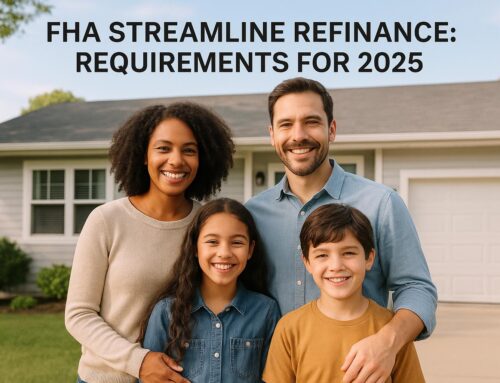Reserve requirements are the liquid assets lenders expect you to have when applying for an investment property loan. These reserves act as a safety net to ensure you can cover mortgage payments during tough times, like vacancies or unexpected expenses. Here’s what you need to know:
- What are reserves? Cash or assets equal to 2-6 months of your monthly mortgage payments (PITI: principal, interest, taxes, insurance).
- Why do they matter? They protect both you and the lender from financial risks, ensuring you can manage your property even during income disruptions.
- Who needs them? Anyone applying for loans on investment properties or second homes. Requirements are stricter than for primary residences.
Key Factors That Affect Reserves:
- Loan Type: Conventional loans may require up to 6 months, while jumbo loans can need 12 months. FHA loans are more lenient.
- Number of Properties: More properties mean higher reserve requirements. For example, owning 7+ properties may require 6-8 months of reserves.
- Credit Score & Income Stability: Higher scores and steady income can lower reserve demands.
Quick Calculation:
Multiply your monthly mortgage payment (PITIA) by the required months of reserves. Example: $2,000 PITIA × 6 months = $12,000 reserves.
Acceptable Reserve Sources:
- Checking/savings accounts, retirement accounts, stocks, and bonds.
- Unacceptable: Personal loans, non-vested funds, or cash proceeds from refinancing.
Having reserves signals financial stability and can improve your loan approval chances. Start building reserves early to avoid surprises during the loan process.
What Reserves Do Fannie Mae & Freddie Mac Require?
What Affects Reserve Requirements
When it comes to determining your reserve requirements, several key factors come into play. These variables shape how much cash you’ll need to set aside and can guide you in selecting the loan program that best fits your financial situation.
Loan Type and Program
The type of loan you choose has a big impact on your reserve requirements. Here’s how different loan types stack up:
- Conventional loans: These loans often require up to six months of reserves for investment properties and prefer a debt-to-income ratio of 43% or lower. They focus heavily on your personal income, so you’ll need to provide detailed documentation like tax returns, W-2s, and pay stubs.
- DSCR loans (Debt Service Coverage Ratio): These loans look at the rental income potential of the property rather than your personal income. They don’t require income verification, but they usually come with higher interest rates and require a down payment of 20-25%. As Venice Luckx, Sales Director at Society Mortgage, notes:
"Different lenders may set varying requirements for DSCR loans; choose one that aligns with your investment strategy." [4]
- FHA loans: These are more lenient, often requiring just one to two months of reserves. However, they’re limited to primary residences and include mortgage insurance.
- Jumbo loans: On the opposite end of the spectrum, jumbo loans often require up to 12 months of reserves due to the larger loan amounts involved [5].
Here’s a quick comparison:
| Loan Type | Reserve Requirements | Key Features |
|---|---|---|
| Conventional | Up to 6 months | Requires income verification, 70% of market |
| DSCR | Varies by lender | No income verification, higher interest rates |
| FHA | 1-2 months | Primary residence only, includes mortgage insurance |
| Jumbo | Up to 12 months | Stricter requirements for large loan amounts |
Your loan type is just one piece of the puzzle. The number of properties you finance also plays a significant role in determining your reserve needs.
Number of Financed Properties
As your portfolio grows, so do the reserve requirements. Lenders view borrowers with multiple properties as higher risk, which translates into the need for larger cash reserves.
- Fannie Mae: Reserve requirements are based on a percentage of your total unpaid principal balance (UPB). For 1-4 financed properties, you’ll need reserves equal to 2% of your UPB. This increases to 4% for 5-6 properties and 6% for 7-10 properties. At the 7-10 property level, you’ll also need a minimum credit score of 720 [6].
- Freddie Mac: Their system is based on months of PITI (Principal, Interest, Taxes, and Insurance) payments. For 1-6 properties, you’ll need 2 months of PITI reserves. For 7-10 properties, this jumps to 8 months, along with the same 720 credit score requirement [6].
Here’s a breakdown:
| Properties Financed | Fannie Mae Requirements | Freddie Mac Requirements |
|---|---|---|
| 1-4 properties | 2% of UPB | 2 months PITI |
| 5-6 properties | 4% of UPB | 2 months PITI |
| 7-10 properties | 6% of UPB (720 FICO required) | 8 months PITI (720 FICO required) |
Beyond property count, your personal financial profile further influences how much you’ll need to reserve.
Borrower’s Financial Profile
Your financial standing is another key factor that lenders evaluate when setting reserve requirements. Here’s what they look at:
- Credit scores: A strong credit score can work in your favor. For conventional loans, a minimum score of 620 is required with a 25% down payment, or 680 with a 15% down payment for investment properties [7]. DSCR loans often require even higher scores, typically 680 or above.
- Income stability: Conventional loans place a lot of emphasis on stable income. If you’re self-employed or have variable income, lenders may see you as a higher risk and require more reserves. This is especially true for investment properties, which already carry additional risk.
- Interest rates: Investment property loans usually come with interest rates that are 0.5% to 0.75% higher than those for primary residences [7]. Higher rates mean higher monthly payments, which directly impacts the amount of reserves you’ll need.
Lenders use a combination of these factors to assess your overall risk profile. Borrowers with strong credit, steady income, and fewer financed properties will generally face lower reserve requirements. On the other hand, if you have multiple risk factors, you’ll need a larger financial cushion to secure a loan.
How to Calculate Reserve Requirements
Accurately calculating reserve requirements is a key step in managing risk and ensuring compliance with lender guidelines. While the math itself is straightforward, precision is essential to secure your investment property loan.
Understanding PITIA
Before diving into reserve calculations, it’s important to grasp PITIA, which represents the five components of your total monthly mortgage payment. Dana Hendrix, Senior VP of Finance at DSLD Mortgage, emphasizes:
"Understanding PITIA is crucial for accurately estimating your total monthly housing costs." [8]
Here’s what each part of PITIA includes:
- Principal: The portion of your payment that reduces your loan balance.
- Interest: The cost of borrowing money, paid to your lender.
- Taxes: Your annual property taxes, divided into monthly installments.
- Insurance: Covers homeowner’s insurance and any required mortgage insurance.
- Association dues: Applicable if your property is part of a homeowner’s or condo association.
To ensure your calculations are accurate, make sure you have reliable estimates for property taxes and association dues.
Calculating Reserve Amounts
The formula for reserve requirements is simple: multiply your monthly PITIA by the number of months your lender or loan type specifies. These reserves reflect how many months of PITIA you could cover using your financial assets [3].
Here’s the process:
- Calculate your monthly PITIA: Add up all five components.
- Determine the required months of reserves: This varies based on your loan type and transaction.
- Multiply PITIA by the required months: This gives you the total reserve amount.
For example, if your monthly PITIA is $2,000 and your lender requires six months of reserves, you’ll need $12,000 in acceptable financial assets.
When evaluating your reserves, don’t forget to subtract funds earmarked for closing costs. This ensures you have enough left over to meet reserve requirements [3].
Example Scenarios
Let’s look at how these calculations play out in real-world examples:
FHA Multifamily Investment Example: Imagine you’re purchasing an FHA triplex priced at $311,000 with a 3.5% down payment (roughly $11,000), closing costs of $7,000, and a monthly PITIA of $2,440. With a requirement of three months of reserves, you’d need $7,320 in reserves, bringing your total cash requirement to $25,320 [9].
Multiple Property Scenario: Reserve requirements increase when you own multiple properties. For instance, under Fannie Mae guidelines, if you already own four financed investment properties and are purchasing a fifth, you’d need reserves equal to 4% of your total unpaid principal balance across all properties. If your combined loan balances amount to $1,500,000, your reserve requirement would be $60,000 ($1,500,000 × 4%).
Reserve Requirements by Loan Type and Property Units
The table below breaks down reserve requirements based on loan type and property size:
| Loan Type | 1 Unit | 2 Units | 3 Units | 4 Units |
|---|---|---|---|---|
| FHA | 0 | 0 | 3 | 3 |
| Conventional | 0 | 6 | 6 | 6 |
| USDA | 0 | n/a | n/a | n/a |
| VA | 0 | 6 | 6 | 6 |
The numbers represent the required months of reserves [9].
Acceptable and Unacceptable Reserve Sources
Reserves must come from approved sources. Acceptable examples include:
- Checking and savings accounts
- Stocks, bonds, and mutual funds
- Retirement accounts
- The cash value of life insurance policies
On the other hand, reserves cannot include:
- Non-vested funds or inaccessible accounts
- Stock in unlisted corporations
- Unsecured personal loans
- Cash proceeds from a cash-out refinance on the subject property [3]
sbb-itb-8115fc4
What Assets Count for Reserve Requirements
Once you’ve figured out how much you need to set aside for reserves, the next step is understanding which assets can be used to meet those requirements. Knowing what qualifies ensures you’re well-prepared and helps avoid any last-minute surprises during the loan process. Lenders have clear guidelines on what counts as acceptable reserves, and sticking to these criteria is crucial for securing financing smoothly.
Liquid Assets
Liquid assets are the most straightforward option since they’re funds that can be accessed right away after closing. Lenders tend to favor these because of their immediate availability[10].
The basics? Your checking and savings accounts are the foundation of liquid assets[3][10]. Beyond that, certificates of deposit (CDs) also qualify, even if there’s an early withdrawal penalty[3][11]. Money market funds are another solid choice, and trust accounts can count as long as the funds are easily accessible[3][11].
But liquid assets aren’t your only option – retirement and investment accounts can also play a role in meeting reserve requirements.
Retirement and Investment Accounts
If you have vested retirement accounts, such as 401(k)s or IRAs, these can be used for reserves, provided they meet certain conditions[3][10][11]. The key is that the funds must be vested and available for withdrawal at any time[13]. Lenders will verify both ownership and accessibility, but they won’t require you to actually withdraw the funds[13].
Similarly, investment accounts – like those holding stocks, bonds, or mutual funds – are often eligible[3][10]. However, if your retirement funds are tied up in securities, they’ll need to meet specific valuation requirements that lenders will carefully review[13]. It’s worth noting that non-vested stock options and restricted stock don’t qualify because they don’t guarantee access to the funds[3][11].
Another asset to consider is the cash value of vested life insurance policies, which can also count toward your reserves[3][10][11].
Equity in Other Real Estate
If you own other properties, you might be able to use real estate equity as part of your reserves. However, this option is more complex and varies by lender[14]. Typically, lenders will evaluate the current market value of the property and subtract any outstanding mortgage balances to determine how much equity is available. This can be especially useful if you own multiple investment properties, as lenders may require reserves calculated as a percentage of your total mortgage balances[12].
It’s important to note that gift funds can count toward reserves, but gifts of equity do not qualify[10][11].
What Doesn’t Count?
Certain assets are off-limits for reserve requirements. These include:
- Personal unsecured loans
- Cash proceeds from refinancing the property in question
- Non-vested funds
- Stock in unlisted corporations
- Cash stored at home[3][11]
Being aware of these restrictions can save you from unnecessary delays during the loan approval process.
Ultimately, finding the right mix of assets is critical. Combining liquid savings with vested retirement accounts often provides the most flexibility while ensuring you meet reserve requirements without a hitch.
Tips for Managing Reserve Requirements
Navigating reserve requirements doesn’t have to feel like an uphill battle. With a thoughtful approach, steady discipline, and occasional expert input, you can build and maintain reserves without derailing your financial plans. Here’s how to stay on track.
Building Your Reserves Over Time
Think of your reserve fund as a non-negotiable expense. Automating monthly contributions to a dedicated reserve account can make this process seamless [2]. Even if you start small, you can gradually increase your contributions as your financial situation improves.
For example, if your net available rent is $700 per month, it would take about 22 months to save $15,600, enough to cover one year of building expenses [15]. The rule of thumb is simple: save all net rents until you’ve built a reserve that covers a full year of property expenses [15]. This should take precedence over acquiring new properties. If your property isn’t generating positive cash flow, consider supplementing reserves with funds from other sources [1].
Once you’ve tapped into your reserves, replenishing them quickly becomes just as important.
Replenishing Reserves After Use
Using your reserves for unexpected costs isn’t a setback – it’s exactly what they’re there for. The challenge lies in rebuilding them efficiently.
"A savings account is designed to be spent. If clients use the money in their emergency fund for a surprise expense, that’s okay because that’s what it’s there for. Life happens and we can’t predict the impact. Try not to feel guilty about that. Unfortunately, if you don’t have the emergency reserve but more unexpected expenses come up, you’re digging yourself deeper into the hole, which means spending more [on] credit cards and even withdrawing from your retirement funds." – Derek Ripp, Certified Financial Planner and Partner at Austin Wealth Management [17]
Rebuilding your reserves should become your top priority after any use. Avoid spending cash flow from your property until your reserve account is back to full strength [1]. To speed up the process, look for ways to increase your income or cut back on unnecessary expenses [16] [17]. This might mean picking up a side hustle, selling items you no longer need, or canceling nonessential subscriptions [16].
When unexpected windfalls like tax refunds or bonuses come your way, deposit them directly into your reserve fund [16] [18]. During this period, it’s wise to temporarily put other financial goals on hold and focus solely on rebuilding your reserves [17].
Working with Professional Guidance
Managing reserves can get tricky, especially if you’re juggling multiple investment properties or dealing with different loan types. This is where professional advice can make a big difference. Experts can help you not only calculate your reserve needs but also choose the right asset types and financing strategies.
Mortgage brokers, for example, specialize in real estate investment loans and understand the complexities of various financing programs [19]. Statistics show that 68% of real estate investors who worked with mortgage brokers reported higher satisfaction levels. Plus, properties financed with broker assistance closed 30% faster and saved investors an average of 0.25% to 0.50% in interest rates [19].
"More than just loan facilitators, mortgage brokers become fervent advocates for investors, unlocking doors to success through unparalleled expertise, strategic advocacy, and unwavering support." – Derek Ripp, Certified Financial Planner and Partner at Austin Wealth Management [20]
When choosing a broker, look for someone experienced in fix-and-flip projects, multifamily properties, and rental property loans [19]. They should have access to private and hard money lenders, and their expertise should be backed by testimonials and case studies. Clear communication about loan terms is essential.
For instance, HomeLoanAgents offers tailored, tech-driven mortgage solutions specifically for investors. Their DSCR loan programs are designed with investment properties in mind, making them a solid option for both first-time investors and those managing multiple properties. Having personalized mortgage solutions can simplify navigating reserve requirements and loan processes.
The benefits of professional guidance go beyond securing a loan. Mortgage brokers can help you understand serviceability thresholds, connect you with other key professionals like appraisers or attorneys, and provide ongoing support for refinancing or renegotiating loan terms [20] [21] [22]. Often, the value of expert advice pays off through better loan terms, quicker closings, and the reassurance that your reserve strategy aligns with your long-term investment goals.
Conclusion: The Importance of Reserve Requirements
Reserve requirements act as a critical safety net, protecting both borrowers and lenders in the often unpredictable world of real estate investing. Meeting these requirements can be the key to securing financing on favorable terms and ensuring you don’t miss out on lucrative opportunities.
Because investment properties carry a higher level of risk, lenders typically require borrowers to hold reserves covering two to six months of mortgage payments [12]. This standard is rooted in years of industry insights, showing that borrowers with adequate reserves are better equipped to handle unexpected financial hurdles.
Loans for investment properties also come with higher interest rates – usually 0.5% to 0.75% above those for primary residences – partly due to stricter reserve requirements, which increase borrowing costs [7][23].
If you’re considering a conventional loan, you might need up to six months of reserves. For jumbo loans, the bar is even higher, with some lenders asking for as much as 12 months in reserves [5]. The more properties you finance, the more reserves you’ll need, making it crucial to plan ahead if you’re aiming to grow your portfolio.
Managing reserves effectively is not only achievable but also essential for long-term success in real estate investing. HomeLoanAgents, a leader in investment property financing, understands the unique hurdles investors face. Their DSCR loan programs – discussed earlier – offer flexible qualification options, making it easier to maintain the reserves you need while locking in competitive terms.
Whether you’re just starting out or expanding your real estate holdings, having enough reserves signals financial stability and responsibility to lenders [7]. This often translates into better loan terms and quicker approvals. In the end, real estate investing isn’t just about having money; it’s about being prepared with the right money, in the right place, at the right time. A solid reserve strategy is key to securing the financing you need and building a foundation for long-term success.
FAQs
What are the differences in reserve requirements for investment properties versus primary residences?
When it comes to reserve requirements, investment properties often demand a larger financial cushion compared to primary residences. Lenders usually ask for six months’ worth of mortgage payments – covering Principal, Interest, Taxes, Insurance, and Association fees (PITIA) – for investment properties. This buffer helps ensure owners can manage costs during tenant vacancies or handle surprise expenses.
On the other hand, reserve requirements for primary residences are generally lower, typically ranging from zero to three months of mortgage payments. Lenders see these as less risky because homeowners are more likely to make their own home a payment priority. The higher reserve requirements for investment properties reflect the increased risk, as the owner doesn’t live there and might not treat the mortgage with the same urgency.
How can I build and maintain reserves for my investment properties?
Building and maintaining reserves is essential for safeguarding your investment properties against surprise expenses while ensuring financial stability over the long haul. Here are two practical approaches to consider:
- Create a dedicated reserve fund: Set aside savings equal to 1–3 months of rental income for each property. This fund acts as a safety net for emergencies like sudden repairs, unexpected vacancies, or other surprise costs.
- Consistently save a portion of rental income: Make it a habit to allocate a percentage of your monthly rental income – say, 10% – to your reserve fund. This steady approach helps you build a financial cushion over time, preparing you for any challenges that may arise.
By focusing on these strategies, you can protect your investments and enjoy greater peace of mind as a property owner.
Can I use equity from other properties to meet reserve requirements for an investment property?
Yes, you can often tap into equity from other properties to help meet reserve requirements for an investment property. Many lenders allow borrowers to use the equity in their existing properties as part of the asset verification process. In simple terms, the value of your equity can often count toward the reserves needed for your new mortgage.
That said, the exact rules vary depending on the lender and loan type. Some lenders might only allow a portion of the equity to be counted or require it to be easily accessible, while others may impose stricter conditions. It’s important to note that equity usually works as a supplement to, not a replacement for, cash reserves – which are typically equivalent to 2–6 months of mortgage payments. To get a clear picture of what’s required, it’s a smart move to consult your lender or mortgage advisor.
Related posts







